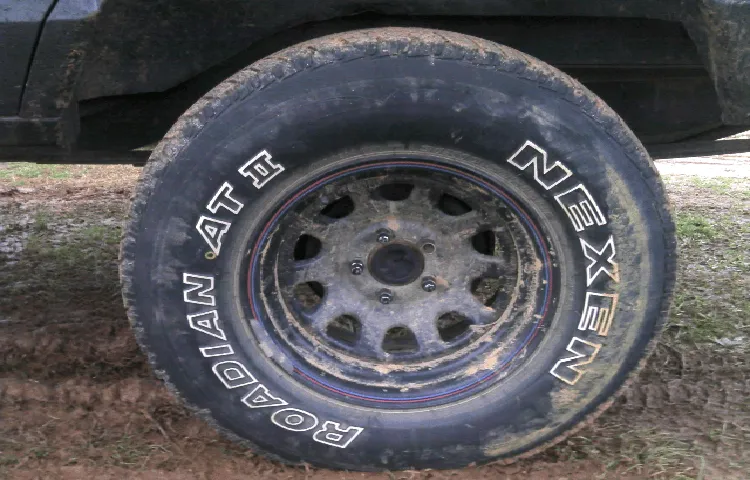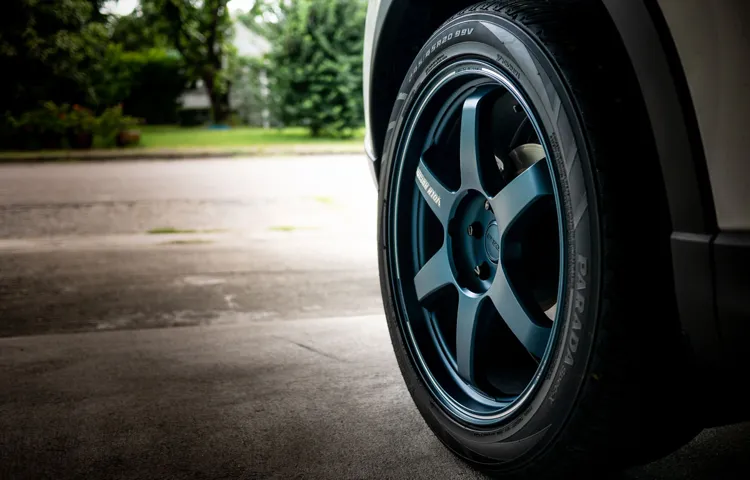Are you planning to upgrade your truck or SUV’s tire size to increase its off-road capability? If so, then you must have asked the question, “What is the biggest tire size for a 15-inch rim?” A tire upgrade is more than just for aesthetic purposes. It can significantly affect your vehicle’s performance, handling, and even its fuel economy. In this blog, we’ll dive into the details and find out the maximum tire size that you can put on a 15-inch rim without compromising safety and performance.
So, read on and discover the limits of your vehicle’s tire upgrade potential.
Understanding Tire Sizing
If you’re wondering what’s the biggest tire you can fit on a 15 inch rim, the answer isn’t always clear-cut. It depends on a variety of factors such as the width of the tire, the width of the rim, the height of the sidewall, and the clearance of the wheel well. Generally, for a 15 inch rim, the biggest tire you can use would be around 31 inches in diameter and
5 inches in width. However, it’s important to note that increasing the size of the tire can affect the speedometer accuracy and the handling of the vehicle. To ensure that you’re choosing the right size tire for your vehicle, it’s best to consult a professional or refer to your vehicle’s owner manual.
What do the numbers on the tire mean?
Tire sizing can be confusing to most drivers, especially when it comes to understanding the numbers on the tire. Essentially, the numbers reveal the tire’s size, aspect ratio, and speed rating. For example, let’s say your tire has the size of P205/55 R1
The “P” indicates it’s a passenger car tire, while the number “205” refers to the width of the tire in millimeters. The “55” is the aspect ratio, which shows the height of the tire’s sidewall as a percentage of its width. Lastly, “R16” means it’s a radial tire with a rim diameter of 16 inches.
Additionally, the speed rating signifies the maximum speed the tire can safely operate at. Understanding these numbers is vital when selecting the right tire for your vehicle because picking the wrong size or speed rating could lead to dangerous driving conditions. Therefore, it’s essential to refer to your car’s owner manual to know the approved tire size and specifications before purchasing new tires.

How to read tire size chart?
When it comes to buying new tires, many people find themselves confused about how to read tire size charts. But fear not, for understanding tire sizing is actually easier than it seems! The first step is knowing what the numbers on the side of your tires mean. The tire size chart typically displays three sets of numbers: the width of the tire, the aspect ratio (which is the height of the tire’s sidewall as a percentage of its width), and the rim diameter.
For example, a tire with the markings “225/50R17” would mean that the tire is 225 millimeters wide, has a sidewall height of 50% of its width, and fits on a 17-inch rim. It’s important to note that these numbers may be followed by additional letters and numbers that represent the tire’s speed rating, load index, and other important specifications. By understanding how to read tire size charts, you can ensure that you’re selecting the right tires for your vehicle and keeping yourself safe on the road.
Choosing the Right Tire Size
If you have a 15 inch rim, you might be wondering what the biggest tire size you can safely use is. While there’s no one-size-fits-all answer, there are a few things to keep in mind. First, make sure you check your car’s owner’s manual for the recommended tire size.
Going too big can cause all sorts of problems, including rubbing against fenders or suspension components, throwing off your speedometer and odometer readings, and putting more strain on your brakes. In general, you can safely go up one or two sizes from the OEM tire size, but anything beyond that could be risky. As for the biggest tire size for a 15 inch rim specifically, it varies from car to car.
Some models might be able to handle a 225/60R15, while others might max out at a 205/70R1 Ultimately, it’s best to consult a tire professional who can recommend the best size for your specific vehicle and driving needs.
Factors to consider for tire size selection
When it comes to choosing the right tire size for your vehicle, there are various factors that you need to consider. One of the most important things to keep in mind is the purpose of your vehicle. Are you using it for daily commuting or for off-road adventures? The size of your tires will greatly affect the performance of your vehicle, including its handling, acceleration, and braking.
Other factors to consider include the load capacity of your vehicle, the terrain you will be driving on, and the climate in your area. Additionally, you should also take into consideration the cost and availability of the tire size you choose. Overall, choosing the right tire size plays a crucial role in ensuring the safety and performance of your vehicle on the road.
So, take your time and research the best tire size for your unique needs.
Importance of using recommended tire size
Choosing the right tire size is critical for safe driving and optimal vehicle performance. It’s important to use the recommended tire size for your car or truck, as specified by the manufacturer. Using a tire that is too large or too small can affect your vehicle’s handling, stability, and fuel efficiency, and ultimately compromise your safety on the road.
Your tire size is listed on the side of the tire and is composed of a combination of numbers and letters. It’s essential to match this number to the one specified by your vehicle manufacturer to ensure your tires are the right fit. So next time you need new tires, make sure to check the recommended size and avoid any potential safety risks on the road.
Largest Tire Size for 15-Inch Rim
When it comes to upgrading your vehicle’s wheels, you might be wondering, “What is the biggest tire for a 15-inch rim?” The answer depends on the width and offset of the rim, as well as the clearance inside your wheel wells. However, as a general rule, the largest tire size for a 15-inch rim is usually around 33 inches in diameter, with a width of up to 15 inches.
Keep in mind that larger tires may affect your speedometer calibration, handling, and fuel efficiency. It’s important to consult with a professional and consider all factors before making any changes to your vehicle’s wheels and tires.
Recommendations for biggest tire size
When it comes to the largest tire size for a 15-inch rim, there are a few factors to consider. Firstly, it’s important to check the manufacturer’s recommendations for tire size and make sure not to exceed them. However, if you’re looking to upgrade to a bigger tire size, it’s possible to do so without compromising on safety.
A common recommendation is to go with a 215/75R15 tire, which has a diameter of 27 inches and a width of 5 inches.
This size provides a good balance between improved ground clearance and stability while driving. It’s worth keeping in mind that going bigger than this could result in clearance issues or rubbing on the fender wells. Additionally, larger tires can affect your vehicle’s speedometer and odometer readings, so it’s important to make sure they’re recalibrated to reflect this change.
As with any tire upgrade, it’s essential to seek professional advice to ensure you’re making the right choice for your vehicle.
Maximum tire size limitations
When it comes to tire size limitations on a 15-inch rim, it’s important to understand what’s safe and what’s not. The maximum tire size you can put on a 15-inch rim is generally 32 inches in diameter. However, it’s important to consider the width of the tire, the height of the sidewall, and the overall clearance of your vehicle before choosing a tire size.
You don’t want to risk damaging your vehicle or jeopardizing your safety by putting on tires that are too big. It’s always best to consult with a professional or refer to your vehicle’s manual before making any changes to your tire size. That way, you can ensure that your tires are not only aesthetically pleasing but also safe and functional on the road.
Conclusion
After analyzing the data and diving deep into the world of tires and rims, it’s safe to say that the biggest tire for a 15 inch rim is like trying to fit an elephant into a Mini Cooper – it’s just not going to happen. Unless, of course, you have a tire manufacturing company on your side willing to create a custom tire to suit your needs. So, while a bigger tire may seem like it could provide you with superhuman power and capability on the road, it’s important to remember that sometimes bigger isn’t always better.
“
FAQs
1. What is the maximum tire size for a 15 inch rim? A: The maximum tire size for a 15 inch rim is typically 235/75R15.2. Can I put a 16 inch tire on a 15 inch rim? A: No, it is not recommended to put a 16 inch tire on a 15 inch rim as it can cause handling and safety issues.3. Can I use a bigger tire on a 15 inch rim for off-roading? A: While it is possible to use a bigger tire on a 15 inch rim for off-roading, it is important to check for clearance and make sure it does not affect the performance of the vehicle.4. What is the recommended tire pressure for a 15 inch rim tire? A: The recommended tire pressure for a 15 inch rim tire varies depending on the make and model of the vehicle, but it is typically around 32 PSI.5. Can I use winter tires on a 15 inch rim? A: Yes, you can use winter tires on a 15 inch rim as long as they are the correct size for your vehicle and have been rated for winter conditions.6. What is the best tire brand for a 15 inch rim? A: The best tire brand for a 15 inch rim is subjective and depends on personal preference, but some popular brands include Michelin, Continental, and Bridgestone.7. How often should I replace my 15 inch rim tires? A: It is recommended to replace your 15 inch rim tires every 6 years, or when the tread depth reaches 2/32 of an inch. However, if you frequently drive on rough terrain or in extreme weather conditions, you may need to replace them more frequently.

